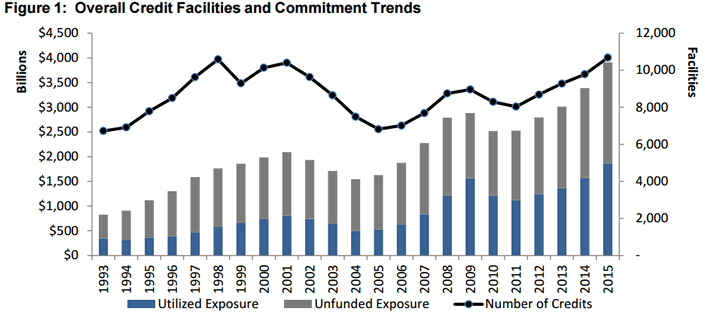Press Release
U.S. Official Warns of ‘Rising Credit Risk’
in U.S. Financial System
November 2015
Nov. 11, 2015 (EIRNS)—Controller of the Currency Thomas Curry warned in Oct. 31 and Nov. 2 public presentations, of “rising credit risk” in the U.S. financial system, despite his office’s repeated warnings to the banks about leveraged loans, in particular.
 View larger size From "Shared National Credits Program 2015 Review", by the Board of Governors of the Federal Reserve System, the Federal Deposit Insurance Corporation and the Office of the Comptroller of the Currency.
Credit facilities include syndicated loans and loan commitments, letters of credit, and commercial leases, and other forms of credit. Commitment amounts include both drawn and undrawn portions of the loans, or facilities. The SNC review reports only the par amounts of commitments, which may differ from the amounts at which loans are carried by investors. |
On Nov. 5, the Federal Reserve published the 2015 Shared National Credits Review (“shared” among the Fed, the FDIC, and the Office of the Controller of the Curency [OCC]). They surveyed (audited) more than 25% of the financial system’s $4 trillion in loans. (This is the closest thing to the real deal in bank regulation today).
The review found that the exploding leveraged loan portfolio of the banks and non-banks had grown another 23% and is very near $1 trillion. Leveraged loans are loans to companies already overindebted by various accounting standards, prior to the loan.
The review highlighted continuing gaps between industry practices and the expectations for safe and sound banking. Leveraged transactions that originated within the past year continued to exhibit structures that were cited as weak by examiners. The review also noted an increase in weakness among credits related to oil and gas exploration, production, and energy services” (total: $276 billion in leveraged loans).
Bad loans were 15% of this ($35 billion), compared to 3.6% in 2014. Overall, bad loans (“classified commitments”) and deteriorating, non-accruing potential bad loans (“special mention commitments”) totaled 9.5% of the entire $4 trillion, or $373 billion. This means that oil/gas borrowers account for more than three-quarters of the bad loans.
Also, two-thirds of this $373 billion in bad loans are assets of investment banks and other non-banks—nearly all of which are owned by commercial bank holding companies.
